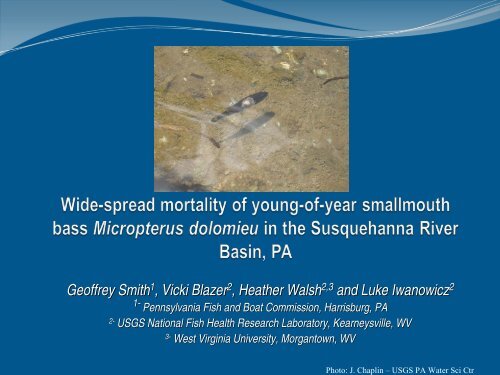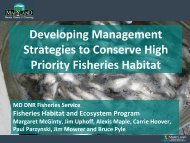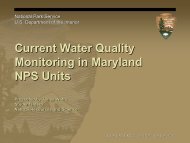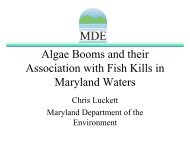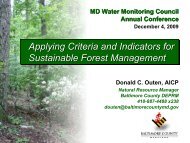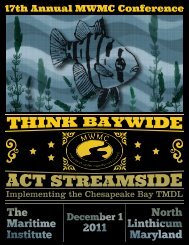Geoffrey Smith (PA Fish and
Geoffrey Smith (PA Fish and
Geoffrey Smith (PA Fish and
You also want an ePaper? Increase the reach of your titles
YUMPU automatically turns print PDFs into web optimized ePapers that Google loves.
Photo: J. Chaplin – USGS <strong>PA</strong> Water Sci Ctr<strong>Geoffrey</strong> <strong>Smith</strong> 1 , Vicki Blazer 2 , Heather Walsh 2,3 <strong>and</strong> Luke Iwanowicz 21- Pennsylvania <strong>Fish</strong> <strong>and</strong> Boat Commission, Harrisburg, <strong>PA</strong>2-USGS National <strong>Fish</strong> Health Research Laboratory, Kearneysville, WVW3-West Virginia University, Morgantown, WV
Issues of concern• Disease in YOY smallmouth bass• Bacterial infections• Parasites• Viral infection• Water quality• Recent concerns with adult smallmouthbass• Intersex• Melanosis• Papillomas
Onset of disease outbreak• First appeared in 2005• West Branch Susquehanna,Susquehanna, <strong>and</strong> Juniatarivers• Affected young-of-year(YOY) smallmouth bass• Disease prevalence as high as70% Photo: J. Cukjati - USGS <strong>PA</strong> Water Sci. Center
Onset of disease outbreak• Varies temporally <strong>and</strong>spatially• Most prevalent during yearswith high water temperature• First documented in tributariesin 2010• First documented outside ofSusquehanna Basin in 2011Photo: J. Chaplin - USGS <strong>PA</strong> Water Sci. Center
Diagnosis• Bacterial infections byFlavobacterium columnare or“columnaris”• A common bacteria found in soil <strong>and</strong>water• Further investigations haveidentified motile Aeromonas spp.<strong>and</strong> Pseudomonas aeruginosaPhotos: K. Stark – PFBC retired
Hypothesis• Immunosuppressed as a resultof stressful water qualityconditions• Why only one life stage of onespecies?• Conditions were most severein the habitats they reside in atthat life stage
Water quality• Paired main channel <strong>and</strong>microhabitat study conductedby USGS (2008 – 2010)• dissolved oxygen• pH• specific conductance• temperaturePhoto: J. Chaplin - USGS <strong>PA</strong> Water Sci. Center
Daily Minimum Dissolved Oxygen, mg/L11109876543E<strong>PA</strong> Water QualityCriterionfor Early LifeStages -WWFSusquehanna River at ClemsonIsl<strong>and</strong> (near New Buffalo, <strong>PA</strong>)20092008May June JulyMAIN CHANNELYOY MICROHABITATFigure: J Chaplin – USGS <strong>PA</strong> Water Sci. Center
Why low DO?• Respiratory dem<strong>and</strong> by aquatic plants• Coincident with longest photoperiod of the year <strong>and</strong>warmest water temperatures• Saturation values also the lowestPhoto: S. Gearhart - PFBC
High pH• A product of excessivephotosynthesis• Wide daily variation• Stressful max values• Affects osmoregulatoryfunction of fish• Many metals <strong>and</strong> othercontaminants becomesoluble again
Why increases in algal productivity?• Recent increases in dissolvedcomponent of phosphorus• Despite decreases in totalphosphorus• Limiting <strong>and</strong> most easily usablenutrient for aquatic plants• Different from other nutrients• Is not related to stream flows• Constant introduction even duringdry periods
BParasites• Heavy infestations by myxozoan<strong>and</strong> trematode parasites• Inflammation <strong>and</strong> occasionalhemorrhage• Wound could lead to infection• Vertebral misalignment <strong>and</strong>muscle damage• Complex life-cycles• Utilize invertebrate intermediatehostsfrom Walsh et al. 2012
Largemouth Bass Virus (LMBV)• Genetic variants explain differentialmortality in bass species?• Sequence data only available for limitedLMBV genes• Based on major capsid protein (MCP)sequencing this is unlikely• Partial MCP gene of 16 isolates sequenced• 100% identical across 500 bp• MCP is typically the most variable in thisfamily of virusPhoto: L. Iwanowicz – USGS NFHRL
Largemouth Bass Virus (LMBV)• Whole genome sequencing (genome ~120 kb)• Next Generation Sequencing (NGS)methods• Difference in genes associated withvirulence could explain difference?• Data pending (issues with host cellcontamination)
Complex relationship of factors• Stressful water quality• Temperature• Nutrients• Dissolved oxygen• pH• Contaminants• Opportunistic bacteria• Parasites• LMBVPhoto: J. Tryninewski - PFBC
Adult smallmouth bass• Intersex• Lesions• Melanosis• Papillomas
Intersex• Endocrine disruption• Frequent <strong>and</strong> severe cases of intersex• As high as 90-100%• High concentrations of vitellogenin in adultmalesPhoto: V. Blazer – USGS National<strong>Fish</strong> Health Research Lab
Evidence of contaminants• Endocrine disruption• 15 PCB congeners• 13 flame retardant compounds• 2 personal care products (triclosan)• 14 organochlorine pesticides• 9 other pesticides
Lesions on adult smallmouth bass• Observed in Autumn 2012• Isolated to small reach of river• Approximately 40 – 50% ofindividuals• Covered 25 – 50% of bodyAngler provided photo
Melanosis• Frequently observed by anglersthis spring• Melanocytes <strong>and</strong> melanosomesin the dermis <strong>and</strong> epidermis ofthe fish.• Melanin is under control of theendocrine (hormone) system
Papillomas• Very low proportion ofindividuals• Currently uncertain whetherrelated to water quality or viralin originAngler provided photo
Summary1. Several fish health issues associated with water qualityissues2. No single factor seems to be a causative1. Synergism?3. Continuing to investigate the roles that each play4. Beginning to look at adult bass1. More recent in occurrence2. Timing of outbreaks make collection complicated
Acknowledgements• Co-authors <strong>and</strong> rest of USGS NFHRL• Jeff Chaplin <strong>and</strong> USGS <strong>PA</strong> Water Science Center• PFBC Division of <strong>Fish</strong>eries Mgmt. staff• USFWS Northeast <strong>Fish</strong>ery Center• Susquehanna River Smallmouth Bass Technical <strong>and</strong>Policy committees• Countless anglers who’ve submitted angler reports/pictures
Questions
NoSurveysNoSurveysNo Survey


